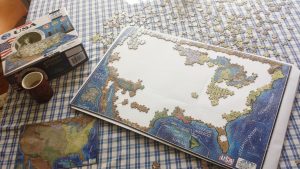
To sum it up, the experience is wonderful so far. Once a week, my kids and I gather around the in-progress puzzle and turn up some background music. There is singing, there is dancing, there are even coloring and spontaneous art creations, and yes, there is also puzzle building. Some of the dancing and happiness is a reaction to their preschool days when their favorite activity was to build a very large floor map of the solar system and planets while listening to a song called “The Sun” by “They Might Be Giants” over, and over, and over, and over again. When the puzzle was complete, my two little ones would proceed to dance from planet to planet, all over the puzzle, and sing along “The sun is a mass of incandescent gas, and gigantic nuclear planet,….” And so our current puzzle project ties back to happy childhood memories for my kids, but I think it can be fun for any kid.
I have found, through trial and error (the former being a state in which I placed my children and the latter being the tenor of the choices I made) that when we get together as a group to learn there are many times that one child or the other is not ready to dive in wholeheartedly. Given that I am not teaching in a rigid school environment, we can accommodate the natural ebb and flow of childhood emotions. And so we do. The only constant is that every week, at the same time, we sit down with the puzzle spread in front of us on the table.
And wonderful things do happen. One week, my son decided to work on the section of the map that covered the Gadsten Purchase, because it was purple and thus the pieces were easily identifiable. The odd name interested him and before I knew it he ran off to his sister’s room to snag the “G” volume of our encyclopedia (my perhaps odd children love reading the encyclopedia at bedtime so the individual volumes sometimes spread across the rooms of our house and must be retrieved in an Easter Egg Encyclopedia hunt). The result was that my boy spent a good half hour reading and learning about that part of US history and then, true to twin form, he went off to spend another half hour teaching his sister what he had read, thus thoroughly cementing the purchase of land from Mexico in the 1850’s in his head forever. And whenever he thinks about the Gadsten Purchase he will, for better or worse, see purple.
This particular puzzle we are using is built in layers, the first being early territory growth and acquisition across the United States. The next layer to lay down is that of the various states, followed by little plastic replicas of important and iconic monuments across the country. While we are currently only about half way through the initial puzzle layer, I am certain this is a much more useful activity for my kids than memorizing state names or capitals. And it definitely was worth the money.